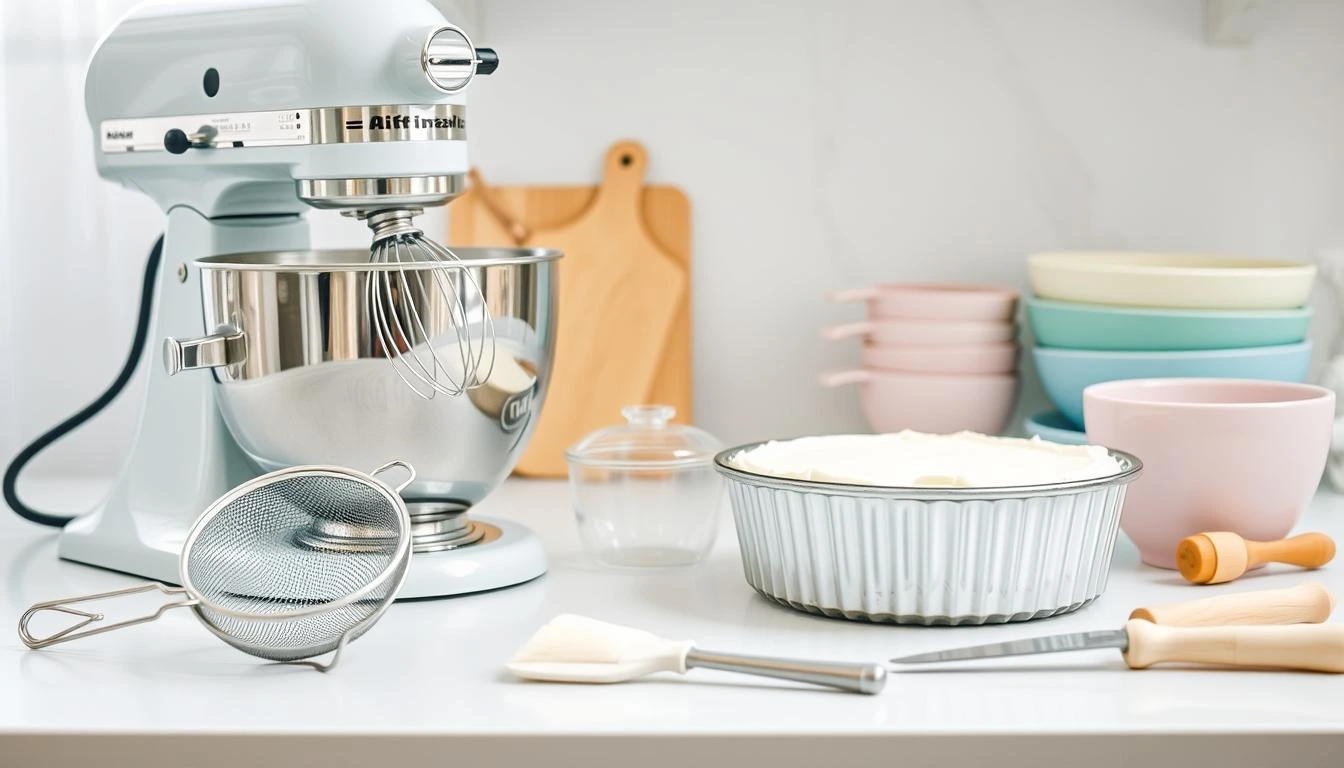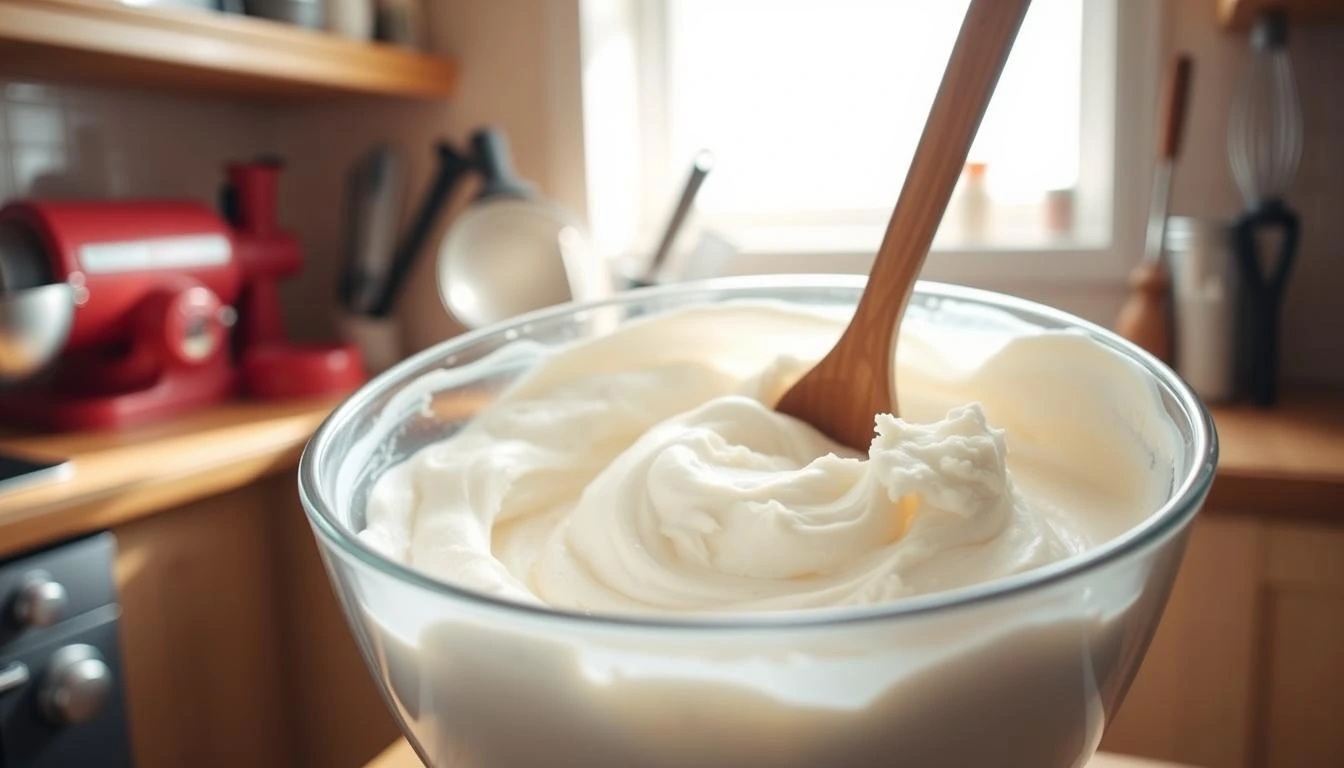Cloud Cake Recipe: Light and Fluffy Homemade Dessert
Table of Contents
Imagine a dessert so light and airy, it feels like biting into a cloud. This unique treat, known as the cloud cake recipe, is a delightful twist on traditional desserts. Made without flour, butter, or oil, it’s perfect for those seeking a lighter option.
The secret to its remarkable texture lies in the simple technique of beating egg whites to perfection. Combined with honey, this creates a fluffy, melt-in-your-mouth experience. Inspired by the classic Portuguese Molotof pudding, this dessert brings a touch of history to your table.
Whether you’re hosting a gathering or treating your family, this cloud cake recipe is ideal. The process involves preparing the batter, baking it in a water bath, and allowing it to cool. The result is a stunning, elegant dessert that’s as easy to make as it is impressive.
In this guide, you’ll find detailed steps, expert tips, and creative twists to master the art of making the best cloud cake recipe. Get ready to wow your guests with this heavenly treat!
Key Takeaways
- Cloud cake recipe is a light, fluffy dessert made without flour, butter, or oil.
- The cloud cake recipe relies on whipped egg whites and honey for its airy texture.
- Inspired by Portuguese Molotof pudding, it combines history with modern simplicity.
- Perfect for gatherings or family treats, it’s both elegant and easy to prepare.
- Follow detailed steps and expert tips to create the perfect cloud cake recipe.
Ingredient Essentials and Tools for Your Cloud Cake Recipe
Creating a light and airy dessert starts with the right ingredients and tools. Every ingredient is essential for creating the ideal texture and flavor. Let’s dive into what you’ll need to make this treat a success.
Key Ingredients: Egg Whites, Honey, and More
Egg whites are the star of this cloud cake recipe. When whipped to stiff peaks, they create the airy structure that defines this dessert. Honey adds natural sweetness and enhances the flavor, while sugar helps stabilize the mixture.
If you’re experimenting with variations, flour can be used to add density. However, the classic version relies solely on egg whites for its lightness. Vanilla extract is optional but adds a warm, aromatic touch.

Essential Equipment and Preparation Tips
Having the right tools is just as important as the ingredients. A stand mixer or hand mixer is essential for whipping egg whites to the right consistency. Use a large mixing bowl to ensure there’s enough space for the batter to expand.
For the perfect shape, a bundt pan or tube pan is recommended. These pans allow heat to circulate evenly, ensuring the dessert bakes uniformly. Before pouring the batter, grease the pan lightly with cooking spray or line it with parchment paper to prevent sticking.
When layering the batter, do so gently to avoid creating large air pockets. This ensures a smooth, even texture. Precision in measuring ingredients is key to maintaining the consistency of the final product.
- Use fresh egg whites for the best results.
- Measure honey and sugar carefully to balance sweetness.
- Grease your pan thoroughly to ensure easy removal.
Mastering the Cloud Cake Recipe: Tips & Techniques
Achieving the perfect texture for your dessert requires mastering a few key techniques. From mixing to baking, each step plays a vital role in creating a light and airy treat. Let’s explore the methods that make all the difference.
Mixing Techniques for Fluffy Batter
The foundation of a fluffy dessert lies in how you mix the ingredients. Start by using a stand mixer or hand mixer to beat egg whites. This method adds air to the batter, ensuring a light texture.
To achieve stiff peaks, beat the egg whites on medium speed until they become frothy. Gradually increase the speed and continue until the mixture holds its shape. Avoid overmixing, as this can cause the air bubbles to collapse.
When folding in other ingredients, use a spatula gently. This preserves the airy structure and ensures an even texture. Patience is key during this step to maintain the fluffiness.

The Importance of a Water Bath in Baking
Using a water bath is crucial for even baking and moisture retention. Place your baking pan inside a larger pan filled with hot water. This method helps regulate the oven temperature and prevents the dessert from drying out.
During baking, avoid opening the oven door. Sudden temperature changes can cause the dessert to sink or lose its texture. Monitor the bake minute timing carefully to prevent overbaking.
After turning off the oven, let the dessert sit inside for a few minutes. This allows it to continue rising and set properly. The result is a perfectly baked treat with a delicate texture.
| Technique | Purpose | Tips |
| Beating Egg Whites | Incorporates air for fluffiness | Use a stand mixer for best results |
| Folding Batter | Preserves airy structure | Use a spatula gently |
| Water Bath | Ensures even baking | Monitor oven temperature |
By following these techniques, you’ll create a dessert that’s both visually stunning and delightfully light. Mastering these steps ensures a perfect result every time.
Creative Variations and Flavor Enhancements
Transform your dessert game with creative twists on a classic favorite. This versatile treat allows you to experiment with flavors, textures, and dietary preferences. Whether you’re craving something rich or looking for a lighter option, there’s a variation for everyone.
Trying Chocolate Cloud Cake Recipe and Other Twists
For a decadent twist, try the chocolate cloud cake recipe. Incorporate cocoa powder or melted dark chocolate into the batter for a rich, indulgent flavor. The result is a dessert that’s both airy and intensely satisfying.
Another option is to prepare the meringue separately. Use it as a topping to add a crunchy, sweet layer. This technique not only enhances the texture but also makes the dessert visually stunning.
Experiment with vanilla extract or even egg yolk variations. Adding yolk can create a denser, protein-rich texture, while vanilla adds a warm, aromatic touch. These small changes can make a big difference in flavor and consistency.
Substituting Ingredients for Dietary Preferences
Adapt this dessert to meet your dietary needs. For a gluten-free version, skip flour entirely or use almond flour. Use honey or maple syrup instead of sugar for natural sweetness.
If you’re looking for a protein boost, consider adding Greek yogurt to the batter. This not only enhances the nutritional value but also adds a creamy texture. Small tweaks like these allow you to enjoy the dessert without compromising on your dietary goals.
Adjusting Sweetness Levels with Honey and Syrups
Customize the sweetness to your liking. Use honey or agave syrup for a milder, natural flavor. For a bolder taste, drizzle condensed milk over the top or add a layer of caramelized sugar.
Remember, even small changes in the amount of sugar or syrup can affect the overall flavor. Start with less and adjust gradually to find the perfect balance for your palate.
“The charm of this dessert is in its versatility. Don’t be afraid to get creative and make it your own.”
By exploring these variations, you can create a dessert that’s uniquely yours. Whether you’re adding chocolate, adjusting sweetness, or catering to dietary needs, the possibilities are endless. Let your imagination guide you and enjoy the process of baking something truly special.
Troubleshooting and Expert Baking Tips
Even the most experienced bakers can face challenges when making delicate desserts. Small mistakes in timing, temperature, or technique can lead to less-than-perfect results. This section will guide you through common issues and provide expert tips to ensure your dessert turns out light, airy, and flawless every time.
Avoiding Overbaking and Maintaining Texture
Overbaking is one of the most common mistakes. Even an extra minute in the oven can turn your dessert from light and fluffy to dense and bread-like. To avoid this, set a timer and check for doneness a few minutes before the recommended baking time. The dessert should be slightly springy to the touch but not firm.
Using a water bath can help maintain moisture and prevent overbaking. Place your pan inside a larger pan filled with hot water. This method ensures even heat distribution and prevents the edges from drying out.
Common Mistakes and How to Fix Them
Common issues and their solutions are listed below:
- Undercooked or Overcooked Results: Slight miscalculations in baking time can lead to uneven results. Use an oven thermometer to ensure accurate temperature and adjust timing as needed.
- Sticking to the Pan: Always line your pan with parchment paper or grease it thoroughly. This ensures easy removal and preserves the dessert’s shape.
- Incorrect Ingredient Measurements: Using the wrong amount of ingredients can affect texture and flavor. Measure carefully, especially when working with large egg whites or sugar.
- Egg Whites Not Whipped Properly: Ensure your mixing bowl is clean and dry before beating egg whites. Grease or moisture can hinder them from achieving stiff peaks.
If you notice air bubbles collapsing during mixing, gently re-fold the batter to restore its structure. Precision is key, from measuring ingredients to monitoring baking time. With these tips, you’ll be able to troubleshoot any issue and create a dessert that’s as beautiful as it is delicious.
Conclusion
This light and airy dessert is a game-changer for any occasion. Its unique texture and flavor come from mastering simple techniques like whipping egg whites and baking at the right temperature. For the best results, serve it at room temperature to enhance its delicate structure.
Using the correct cake pan and measuring ingredients precisely, such as a cup or 1/2 cup, ensures consistency. Small details, like monitoring the oven, can make a big difference in the final outcome.
Feel free to experiment with toppings or side additions to personalize your creation. Once you make cake, share your results and inspire others to try this versatile treat. It’s simple, elegant, and sure to delight!
FAQ
What makes this dessert light and fluffy?
The key lies in properly whipped egg whites, which create air pockets, giving the batter its airy texture. Using a water bath during baking also helps maintain moisture and prevents overbaking.
Can I substitute ingredients for dietary needs?
Yes, you can use alternatives like almond flour or coconut sugar. For a vegan option, aquafaba can replace egg whites, though the texture may vary slightly.
How do I prevent the batter from deflating?
Carefully fold the whipped egg whites into the batter with a spatula. Avoid overmixing, as this can release the air and result in a denser texture.
What’s the role of a water bath in baking?
A water bath ensures even heat distribution, preventing cracks and helping the dessert rise gently. It also keeps the texture moist and tender.
Can I add flavors like chocolate or vanilla?
Absolutely! Incorporate cocoa powder for a chocolate twist or vanilla extract for a classic flavor. Just ensure these additions are well-mixed into the batter.
How do I know when it’s done baking?
Insert a toothpick into the center; it should come out clean. The top should be golden and spring back lightly when touched.
What’s the best way to store leftovers?
Store in an airtight container at room temperature for up to two days. For longer storage, refrigerate it, but bring it to room temperature before serving.
Can I use a hand mixer instead of a stand mixer?
Yes, a hand mixer works well for whipping egg whites. Just ensure you beat them until stiff peaks form for the best results.
